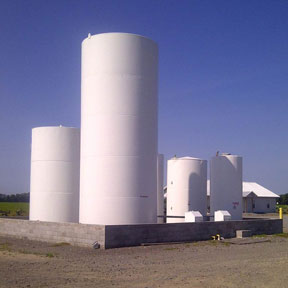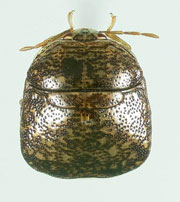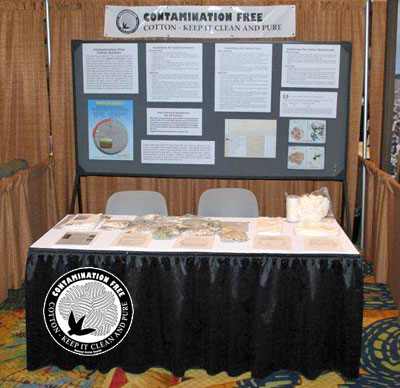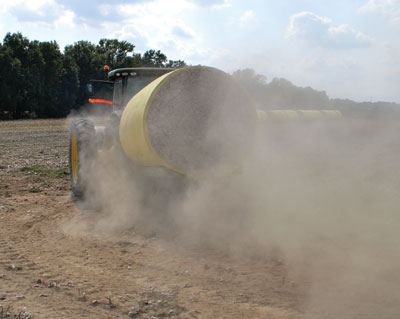Regulatory
NCC President/CEO Mark Lange wrote to thank Senator Kay Hagan (D-NC) for filing, in conjunction with Senator Mike Crapo (R-ID), an amendment to the Senate farm bill that essentially included the language of H.R. 872. Her amendment, which was not voted on, would have overturned a 2009 federal appeals court ruling requiring the agency to issue permits for pesticides sprayed over water. Later, Senators Hagan and Crapo introduced the Restoring Effective Environmental Protection (REEP) Act (S. 3605), which included identical language from H.R. 872 and which clarified that Clean Water Act (CWA) permits are not required for pesticides applied in accordance with FIFRA.
 The NCC updated materials on its website that helped explain the Oil Spill Prevention, Control, and Countermeasure Program basics. |
The NCC also continued monitoring various CWA issues in conjunction with the Water Advocacy Coalition and the Agriculture Nutrient Policy Council. Included were visits to the Office of Management & Budget and Congressional members. A key issue was EPA's advancement of its controversial guidance clarifying when isolated wetlands, intermittent streams and other marginal waters are subject to regulation under the CWA.
The EPA extended the deadline from November 10, 2011 to May 10, 2013, by which owners or operators of a farm must prepare or amend and implement an Oil Spill Prevention, Control, and Countermeasure ProgramPlan (SPCC). The NCC updated materials on its website at www.cotton.org/tech/safety/spccextension.cfm that helped explain the basics of the SPCC Program, including who is covered, what a covered facility should do, current deadlines and where to get more information.
On a conference call with the NCC and other agricultural groups, EPA announced that it was denying a 2008 petition from the Natural Resources Defense Council requesting the revocation of all tolerances and the cancellation of all registrations for 2,4-D. The phenoxy herbicide and plant growth regulator is the third most widely used herbicide behind glyphosate and atrazine and is currently found in about 600 products registered for agricultural, residential, industrial and aquatic uses.
The Advisory Committee on Biotechnology and 21st Century Agriculture (AC21) agreed on compromise recommendations regarding demands from the organic community that they be compensated for losses incurred for the unintended presence of genetically engineered materials in their crops.
Pest Management
The NCC's Environmental Task Force addressed pollinators and their impact on cotton pesticide registrations – a new issue that garnered significant attention.
As colony collapse disorder became a more visible issue, Dr. Don Parker, the NCC's manager of Integrated Pest Management, continued serving on EPA's "Workgroup on Pollinator Protection" that focused on issues of pollinator protection, for both honey bees and native pollinating bees. He told attendees at a CropLife America & RISE (Responsible Industry for a Sound Environment) conference in Washington, DC, that the NCC supports science-based assessments, including the collection of agronomic and other data to better identify the interaction between bees and cotton and identify best management (crop and bee) solutions. Parker also continued serving on the Pesticide Policy Dialogue Committee, which met to discuss a variety of topics, including the pollinator workgroup's latest discussions.
At a Federal Colony Collapse Disorder Steering Committee national stakeholder conference, Parker urged USDA to undertake various actions. Among those were ensuring that pesticide research 1) includes crop/ pollinator experts in order to avoid results that fail to represent field-relevant operations and pollinator behavior and 2) seeks input on issues involving honey bee health.
 The NCC helped demonstrate to the Hondurans that U.S. yarn spinners had sufficient inspection protocols for preventing the loading of kudzu bug-infested yarn or containers. |
NCC staff also served on a North American Pollinator Protection Campaign Pesticide Task Force. That panel published two brochures targeting pollinator protection and published "Pollinator Week" as part of a public awareness campaign. The task force previewed a draft version of a video aimed at promoting best management practices (BMPs) for pesticide applicators to protect pollinators. NCC staff urged the task force to 1) consider that BMPs vary across different regions of the country and the proposed focus on "spray at night" should not be promoted as the only BMP and 2) reconsider the proposed interpretation of label language for pollinator protection -- commenting that the legal authority for label language and definitions for label language resides with EPA.
The NCC Boll Weevil Action Committee's International Technical Advisory Committee appointed a subcommittee to draft plans to standardize boll weevil eradication program activities across the Lower Rio Grande Valley and Tamaulipas, Mexico. The goal is to enhance eradication efforts on both sides of the U.S.-Mexican border by improving coordination and communication between the two programs.
The NCC helped demonstrate to the Hondurans that U.S. yarn spinners had sufficient inspection protocols in place that would prevent the loading of kudzu bug-infested yarn or containers for any destination. The effort came after the USDA-Animal & Plant Health Inspection Service's (APHIS) Plant Protection Quarantine program notified the NCC, the National Council of Textile Organizations and other organizations that Honduras was conducting inspections of all commodities for kudzu bug at ports of entry. However, after a container of U.S. yarn in which live kudzu bugs were found was turned away at a Honduras port late in 2012, the NCC pointed its members to www.cotton.org/tech/flow/kudzu-bug-remediation.cfm. That NCC web page contains links to 1) APHIS' "Protocol for Loading Containers" website and 2) a kudzu bug website developed by the University of Georgia Center for Invasive Species & Ecosystem Health.
Cotton Flow/Packaging
An industry delegation, led by NCC Cotton Flow Committee Chairman Bobby Greene and joined by NCC staff, briefed USDA officials on industry efforts to improve cotton flow. The delegation also sought the agency's cooperation with future industry initiatives. Also participating were representatives from the American Cotton Shippers Association, AMCOT, Cotton Growers Warehouse Association and Cotton Warehouse Association of America.
The NCC's Performance and Standards Task Force, under the auspices of the Cotton Flow Committee,analyzed measures that would ensure the industry meets the demands of a competitive export market.
The 2012 NCC Joint Cotton Industry Bale Packaging Committee (JCIBPC) Specifications for Cotton Bale Packaging Materials were approved by USDA for packaging 2012-crop cotton for Commodity Credit Corporation loan program purposes. A new 8½ gauge wire specification was added in the bale tie section of the specifications. No changes were made to the "Official Tare Weights" table but the table's dates were updated. A "Test Program Review" section was added in front of the specifications. The review section did not affect any of the specifications' bag or tie manufacturing guidelines but provided a summary of the test programs that were granted by the JCIBPC for the 2012-13 marketing year.
In an effort to document bale tie/bag performance and assist the JCIBPC with its evaluation of old and new packaging materials, the NCC encouraged industry members to complete the "Reporting Bale Packaging Performance" form on the NCC website at www.cotton.org/tech/bale/index.cfm. In addition, participating gins, warehouses, shippers and mills involved with materials in the 2012 experimental test programs were encouraged to provide feedback to the JCIBPC prior to its 2013 annual meeting.
USDA-APHIS Memphis office announced that an electronic signature trial, which began in 2010 for Phytosanitary Certificate Issuance and Tracking (PCIT) certificates for baled cotton, was completed. APHIS informed the NCC that any commodity may be certified with an electronic signature – a move that is creating new efficiencies for shippers, marketing cooperatives, freight forwarders and others while reducing the need to create and track paper documents.
Research/Education
 The NCC set up a contamination prevention booth at the NCC-coordinated 2013 Beltwide Cotton Conferences. |
The NCC conducted an extensive contamination elimination initiative with the aim of urging producers, ginners, warehousers and their employees to pay particular attention to contamination prevention during harvest. As part of that effort, the NCC sent out a contamination prevention bulletin to ginners specifically urging them to make sure round module wraps were properly removed from seed cotton in a manner that prevents any wrap from entering ginning systems and baled cotton. As a follow-up, the NCC developed and distributed a poster to gins that emphasized and demonstrated the proper handling of round module wraps.The poster project also involved John Deere, Cotton Incorporated, USDA's Office of Technology Transfer and the National Cotton Ginners Association.
The NCC coordinated the 2012 Beltwide Cotton Conferences. It placed the forum's proceedings on the Beltwide website at www.cotton.org/beltwide/index.cfm?page=proceedings and mailed a proceedings CD to those meeting attendees who requested them.
The NCC and Cotton Incorporated continued as active members in Field to Market – an initiative that joins producers, agribusinesses, food companies, conservation organizations and university and agency partners seeking to create sustainable outcomes for agriculture. Field to Market launched an updated version of the Fieldprint Calculator, an online tool designed to help farmers explore the relationships between management practices and sustainability outcomes. The tool, available at www.fieldtomarket.org, represents just one of the ways the group is working to advance sustainability inside the farm gate while helping farmers tell their sustainability story.
 The NCC examined, for possible impacts on cotton production and ginning, an EPA-proposed rule that would retain the existing 24-hour standard for coarse particulate matter (dust). |
On other technical issues:
- The NCC cooperated with the National Cotton Ginners Association on the three 2012 Ginner Schools:Southwest Ginners School in Lubbock, TX; Western Ginners School in Las Cruces, NM; and the Stoneville Ginners School, Stoneville, MS.
- NCC Director Don Cameron, Helm, CA, addressed a plenary session of USDA's Advisory Committee on Biotechnology and 21st Century Agriculture. He told the Committee, which advises USDA on compensating organic growers who incur economic loss due to pollen flow from neighboring biotech crops, that he produces conventional, biotech and organic crops harmoniously on his San Joaquin Valley farm.
- Patrick Johnson, Jr., a Tunica, MS, cotton producer, was appointed by EPA to its Farm, Ranch, and Rural Communities Committee (FRRCC) to represent cotton industry interests. The FRRCC provides independent policy advice, information and recommendations to the EPA Administrator on a range of environmental issues and policies important to agriculture and rural communities.
- The NCC examined, for possible impacts on cotton production and ginning, an EPA-proposed rule that would retain the existing 24‐hour standard for coarse particulate matter (dust). In place since 1987, this standard's level of 150 μg/m3 was retained in EPA's final rule issued late in the year. The final rule also retained the existing daily standard of 35 µg/m 3 for fine particles but it lowered the primary annual fine particulate matter (PM2.5) standard from 15 micrograms per cubic meter of air (µg/m3) down to 12 µg/m3.

